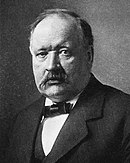അമ്ല-ക്ഷാര പ്രവർത്തനം
| അമ്ലവും ക്ഷാരവും |
|---|
|
Acid dissociation constant Acid-base extraction Acid-base reaction Dissociation constant Acidity function Buffer solutions pH Proton affinity Self-ionization of water |
| അമ്ലം types |
|
Brønsted · Lewis · Mineral ഓർഗാനിക് · Strong Superacids · Weak |
| ക്ഷാരം types |
|
Brønsted · Lewis · Organic Strong · Superbases Non-nucleophilic · Weak |
അമ്ല-ക്ഷാര പ്രതിപ്രവർത്തനം എന്നത് അമ്ലവും ക്ഷാരവും തമ്മിൽ നടക്കുന്ന ഒരു രാസപ്രവർത്തനമാണ്. സൈദ്ധാന്തിക ചട്ടക്കൂടുകൾ ൻൽകുന്നത് പ്രവർത്തനത്തിന്റെ വ്യത്യസ്തമായ ആശയങ്ങളും ബന്ധപ്പെട്ട കണക്കുകൾ പരിഹരിക്കാൻ വേണ്ടിയുള്ള അവയുടെ പ്രയോഗവുമാണ്. അവയുടെ പ്രാധാന്യം പ്രകടമാകുന്നത് വാതകങ്ങളുടേയോ ദ്രാവകങ്ങളുടേയോ അല്ലെങ്കിൽ കുറഞ്ഞ അമ്ല, ക്ഷാര സ്വഭാവം പ്രകടമാകുമ്പോഴോ ഉള്ള അമ്ല-ക്ഷാര പ്രവർത്തനങ്ങളെ അപഗ്രഥിക്കാനാണ്. ഈ ആശയങ്ങളിൽ ആദ്യത്തേത് മുന്നോട്ടു വച്ചത് ഉദ്ദേശം 1776 ൽ ഫ്രഞ്ച് രസതന്ത്രജ്ഞനായ ആന്റോയിൻ ലാവോസിയറാണ്. [1]
അറീനിയസ്സ് സിദ്ധാന്തം
[തിരുത്തുക]
അമ്ലങ്ങളുടേയും ക്ഷാരങ്ങളുടേയും ആദ്യ ആധുനിക നിർവചനം കണ്ടെത്തിയത് സ്വാന്തെ അറീനിയസ്സാണ്. [2] ഒരു ഫ്രീഡ്രിച്ച് വിൽഹേം ഓസ്റ്റ് വാൾഡുമായി ചേർന്ന് 1884 ൽ ജലം ചേർത്ത ലായനിയിലെ അയോനുകളുടെ സാന്നിധ്യം തെളിയിക്കുന്നതിനു വേണ്ടിയുള്ള ഉദ്യമമാണ് അമ്ലങ്ങളുടെ ഹൈഡ്രജൻ സിദ്ധാന്തത്തിലേക്ക് നയിച്ചത്. ഇത് അദ്ദേഹത്തെ 1903 ലെ രസതന്ത്രത്തിലെ നോബേൽ സമ്മാനത്തിനർഹനാക്കി.
അറീനിയസ്സിന്റെ നിർവചനം:
- അറീനിയസ്സ് അമ്ലം എന്നത് ജലത്തിൽ വിഘടിച്ച് ഹൈഡ്രജൻ അയോണുകൾ(H+);[3] ഉണ്ടാക്കുന്ന പദാർത്ഥമാണ്. അതായത്, ഒരു അമ്ലം ജലം ചേർത്ത ലായനിയിലെ H+ അയോണുകളുടെ സാന്ദ്രത കൂട്ടുന്നു.
ഇത് ജലത്തിന്റെ പ്രോട്ടോണികരണത്തിന് അല്ലെങ്കിൽ ഹൈഡ്രോണിയം (H3O+) അയോണിന്റെ രൂപീകരണത്തിന് വഴി വയ്ക്കുന്നു. അങ്ങനെ, ആധുനിക കാലത്ത് H+ എന്ന പ്രതീകം H3O+ ന്റെ ചുരുക്കെഴുത്തായി വ്യാഖ്യാനിക്കപ്പെട്ടു. എന്തുകൊണ്ടെന്നാൽ ഒരു പ്രോട്ടോണിന് ജലം ചേർത്ത ലായനിയിൽ സ്വതന്ത്രമായി നിലനിൽക്കാൻ കഴിയില്ലെന്ന് നമുക്കിപ്പോളറിയാം.[4]
- അറീനിയസ്സ് ക്ഷാരം എന്നത് ജലത്തിൽ വിഘടിച്ച് ഹൈഡ്രോക്സൈഡ് (OH−) അയോണുകൾ ഉണ്ടാക്കുന്ന പദാർത്ഥമാണ്. അതായത്, ഒരു ക്ഷാരം ജലം ചേർത്ത് ലായനിയിലെ OH−അയോണുകളുടെ സാന്ദ്രത കൂട്ടുന്നു.
ബ്രോൺസ്റ്റെഡ്-ലൗറി നിർവചനം
[തിരുത്തുക]  | |
| Johannes Nicolaus Brønsted and Thomas Martin Lowry |
അമ്ലങ്ങളുടെ protonation ന്റെയും ക്ഷാരങ്ങളുടെ de-protonation ന്റെയും അടിസ്ഥാനത്തിൽ ഡെന്മാർക്കിലെ ജോഹാനസ് ബ്രോൺസ്റ്റെഡും ഇംഗ്ലണ്ടിലെ മാർട്ടിൻ ലൗറിയും 1923ൽ ബ്രോൺസ്റ്റെഡ്-ലൗറി നിർവചനം രൂപപ്പെടുത്തിയത് സ്വതന്ത്രമായാണ്. അതായത് ഹൈഡ്രജൻ അയോണുകൾ (H+) അല്ലെങ്കിൽ പ്രോട്ടോണുകൾ വിട്ടുകൊടുക്കാനുള്ള അമ്ലങ്ങളുടെ കഴിവും അവ സ്വീകരിക്കാനുള്ള ക്ഷാരങ്ങളുടെ കഴിവും.[5][note 1]
ഒരു അമ്ല-ക്ഷാരപ്രതിപ്രവർത്തനമെന്നത് അമ്ലത്തിൽ നിന്നുള്ള ഹൈഡ്രജൻ അയോണിന്റെ നീക്കം ചെയ്യലും അതിനെ ക്ഷാരം സ്വീകരിക്കുന്നതുമാണ്. [6] അമ്ലത്തിൽ നിന്നുള്ള ഹൈഡ്രജൻ അയോണിന്റെ നീക്കം ചെയ്യൽ ഇതിന്റെ കോഞ്ജുഗേറ്റ് ക്ഷാരം ഉണ്ടാക്കുന്നു. ഇത് ഒരു ഹൈഡ്രജൻ അയോൺ നീക്കം ചെയ്യപ്പെട്ട ഒരു ആസിഡാണ്. ക്ഷാരത്തിന്റെ പ്രോട്ടോൺ സ്വീകരണം ഇതിന്റെ കോഞ്ജുഗേറ്റ് അമ്ലം ഉണ്ടാക്കുന്നു. ഇത് ഒരു ഹൈഡ്രജൻ അയോൺ കൂട്ടിച്ചേർക്കപ്പെട്ട ഒരു ക്ഷാരമാണ്.
ലൂയീസ് നിർവചനം
[തിരുത്തുക]ഗിൽബെർട്ട് എൻ. ലൂയീസ് 1923 ൽ [7] മുന്നോട്ടുവെച്ച അമ്ല-ക്ഷാരപ്രതിപ്രവർത്തനങ്ങളുടെ ലൂയീസ് നിർവചനം ഹൈഡ്രജൻ ആവശ്യമായിരുന്ന അറീനിയസ്സിനേയും ബ്രോൺസ്റ്റെഡ്-ലൗറിയേയും നീക്കം ചെയ്തു. ബ്രോൺസ്റ്റെഡ്-ലൗറിയുടെ അതേ വർഷത്തിൽത്തന്നെയായിരുന്നെങ്കിലും 1938 വരെ അദ്ദേഹം അത് വിപുലമാക്കിയില്ല.അമ്ല-ക്ഷാരപ്രതിപ്രവർത്തെ പ്രോട്ടോണുകളുടേയോ മറ്റ് ബന്ധിത പദാർത്ഥങ്ങളുടേയോ അടിസ്ഥാനത്തിൽ നിർവചിക്കുന്നതിനു പകരം ലൂയീസ് നിർവചനം ഒരു ക്ഷാരത്തെ (ലൂയീസ് ക്ഷാരമായി പരിഗണിച്ചു) നിർവചിച്ചത് ഒരു ഇലക്ട്രോൺ ജോഡി വിട്ടുകൊടുക്കാൻ കഴിയുന്ന സംയുക്തമായും അമ്ലത്തെ (ഒരു ലൂയീസ് അമ്ലം) ഇലക്ട്രോൺ ജോഡി സ്വീകരിക്കാൻ കഴിയുന്ന സംയുക്തവുമാണ്. [8]
ഇതും കാണുക
[തിരുത്തുക]- Electron configuration
- Lewis structure
- Resonance structure
- Protonation and Deprotonation
- Nucleophilic substitution and Redox reactions
- Acid–base titration
കുറിപ്പുകൾ
[തിരുത്തുക]- ↑ "Removal of a proton from the nucleus of an atom does not occur - it would require very much more energy than is involved in the dissociation of acids."
അവലംബം
[തിരുത്തുക]- ↑ Miessler, G.L., Tarr, D. A., "Inorganic Chemistry" (1991) p. 166 – Table of discoveries attributes Antoine Lavoisier as the first to posit a scientific theory in relation to oxyacids.
- ↑ "On the Influence of Carbonic Acid in the Air Upon the Temperature of the Ground" (PDF). Philosophical Magazine and Journal of Science. 41 (5): 237–276. 1896.
- ↑ Miessler, G. L., Tarr, D. A., (1991) "Inorganic Chemistry" 2nd ed. Pearson Prentice-Hall p. 165
- ↑ LeMay, Eugene (2002). Chemistry. Upper Saddle River, New Jersey: Prentice-Hall. p. 602. ISBN 0-13-054383-7.
- ↑ Miessler, G. L., Tarr, D. A., (1991) "Inorganic Chemistry" 2nd ed. Pearson Prentice-Hall pp. 167–169 – According to this page, the original definition was that "acids have a tendency to lose a proton"
- ↑ Clayden, J., Warren, S., et al. (2000) "Organic Chemistry" Oxford University Press pp. 182–184
- ↑ Miessler, L. M., Tar, D. A., (1991) "Inorganic Chemistry" 2nd ed. Pearson Prentice-Hall p. 166 – Table of discoveries attributes the date of publication/release for the Lewis theory as 1923.
- ↑ Miessler, G. L., Tarr, D. A., (1991) "Inorganic Chemistry" 2nd ed. Pearson Prentice-Hall pp. 170–172
പുറം കണ്ണികൾ
[തിരുത്തുക]Text is available under the CC BY-SA 4.0 license; additional terms may apply.
Images, videos and audio are available under their respective licenses.
